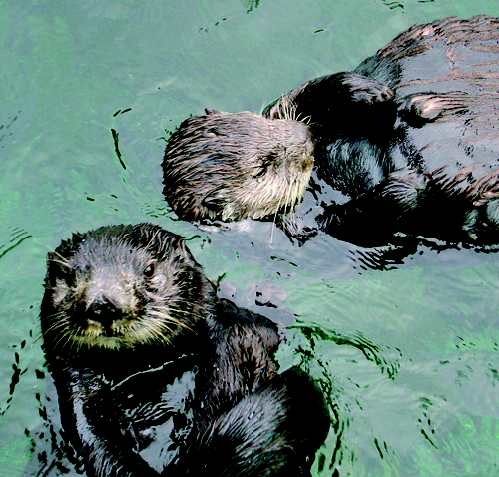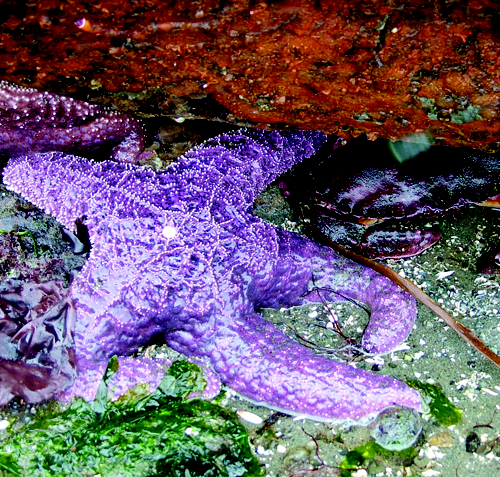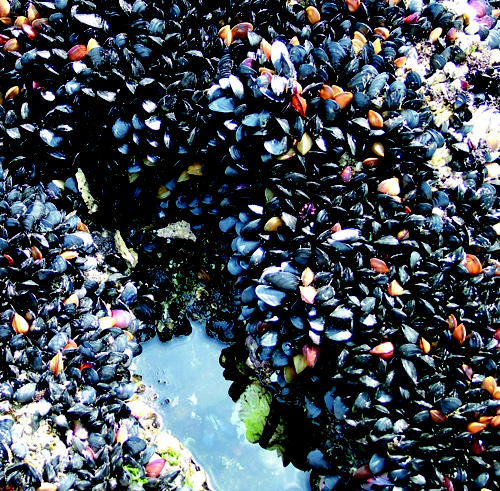Food Web
Puget Sound hosts more than 100 species of seabirds, 200 species of fish, 15 marine mammal species, hundreds of plant species, and thousands of invertebrate species. These species do not exist in isolation, but rather interact with each other in a variety of ways: they eat and are eaten by each other; they serve as vectors of disease or toxins; they are parasitic; and they compete with each other for food, habitat, and other resources.

Species and Food Web
The array of species found in Puget Sound reflects its high productivity, the wide diversity of habitats present, and its unique geographic location at the interface of “northern” and “southern” ranges for many species. There is no single food web in the Puget Sound ecosystem. Instead there are many marine food webs that reside in the soft-bottomed nearshore, in rocky-bottomed areas, in habitats dominated by eelgrass or kelp, and in pelagic areas as well. Similarly, there are terrestrial and freshwater aquatic food webs that occur in alpine habitats, mid-elevation and lowland forests, and rivers, lakes, and streams. The food webs in each of these areas are not discrete and independent, but rather are highly interconnected by organic matter sources, physical proximity, exchange of water, and organisms that change habitats during the course of their life cycles.
Food webs also change both in time and space due to variation in stratification, prey availability, organic-matter source availability and quality, and other local and regional conditions. In addition, some species occupy multiple places or play multiple roles in the food web depending on their life stage, size, habitats they occupy, and time of year. Juvenile crab zoea, for example, live in the water column and are planktivorous, while adult crabs are bottom scavengers and predators.
Inter-species relationships
The relationships between species and “levels” in the food web are not strictly linear, as some species eat at many levels. Additionally, changes to the abundance and distribution of a single species (top-level predator or primary producer) may indirectly affect numerous other species.
Sea Otters
For example, the presence and abundance of sea otters (a top-level predator) has been shown to have a cascading effect on the structure of the food web in kelp forests. Sea otters consume herbivorous sea urchins, which consume bull kelp and other fleshy algae. By keeping the urchins in check, the sea otters allow kelp forests to thrive, which provides three-dimensional habitat and nutritional fuel for fish species such as rock greenling that use the kelp forests for feeding, shelter and egg laying (Reisewitz et al. 2006).

Eelgrass
At the other end of the food web, the loss of primary producers such as eelgrass may have similarly complex ramifications for other species. Eelgrass plays an important role to several commercially-important species in Puget Sound. Eelgrass is the preferred medium for Pacific herring for laying eggs and foraging. Meadows of eelgrass provide cover from predators and refuge from currents for migrating juvenile salmon in the nearshore, who will in turn depend on the availability of herring and other prey species as they mature and return. Dungeness crab mate and take refuge in eelgrass meadows. Eelgrass and the epiphytes that live on its blades are a major food source for small species of invertebrates. Eelgrass also contributes substantially to detrital food pathways. As eelgrass declines or the vegetated areas become fractured and dispersed, the entire chain of dependent organisms is affected.
Beyond marine areas
In the same way that Puget Sound physical processes are linked to ocean, freshwater, and terrestrial environments, the Puget Sound food webs described above do not exist in isolation and are connected by organisms that reside or migrate outside of Puget Sound marine waters. Changes to the abundance and relationships of species within Puget Sound may be affected by changes in the open ocean or terrestrial landscape.
Migratory waterbirds
For example, many waterbird species, including loons, grebes, scoters, murres, and murrelets, move to the protected waters of Puget Sound for the winter and feed on Puget Sound species, thus are transient members of the food web. Recent studies in Puget Sound and surrounding waters have shown 50-95% declines in populations of many marine bird species during the past 20 years (Nysewander et al. 2001, Bower 2004). The species that have shown the most alarming declines (80-95%) are diving birds such as common and red-throated loons; western, red-necked and horned grebes; and marbled murrelets, all of which specialize in schooling pelagic fish (Nysewander et al. 2001, Bower 2004). Marked declines have also been observed in summer breeding populations of fish-eating seabirds. Moderate but still serious declines (50-60%) have also been observed in a variety of birds that are less dependent on pelagic forage fish because they can also subsist on benthic or demersal fishes (e.g., cormorants and guillemots) and subtidal or intertidal invertebrates (e.g., gulls and scoters). Declines in these waterbirds may reflect declines in species that are harder to count, such as small benthic or pelagic fishes. Forage fish species may be affected by changes in habitat and physical processes both within and outside of Puget Sound, with ramifications to food webs across broader areas.
Other migratory species
The movements of transient and migratory species also connect Puget Sound with the rest of the North Pacific. Some marine mammals such as sea lions and orcas spend just a portion of the year in the waters of Puget Sound, migrating to other areas at other times of the year. Salmon are an outstanding example of complex food-web linkages as they rear in freshwater and estuarine environments, migrate to marine waters and the open ocean, and return to transfer nutrients to terrestrial species such as eagles and bears. Additionally, salmon can simultaneously occupy multiple places in the food web depending on their life stage, size, habitats, and time of year.
Competition
In addition to the transfer of energy up a food chain, other species interactions can be important to the functioning of the freshwater, estuarine, and marine communities that comprise the Puget Sound ecosystem. Competition with and among species can influence food-web dynamics and species distribution and abundance.
For example, on the rocky habitats of Puget Sound, the survival of species can depend on their ability to adapt to the vagaries of wind and waves, to compete for space, and to outgrow their predators. Starfish (Pisaster ochraceus) prey on mussels (Mytilus spp.) in this rocky, intertidal zone, yet these species can be found living in close proximity for decades. Where starfish are dense and have been present for a long time, there are no large mussels and local species diversity is low. However, if the mussels can survive for a few years at the high edge of the intertidal zone, or by accident or ineptness on the part of their predators, they become too large for the starfish to eat, reproduce disproportionately, and develop complex, multi-dimensional colonies that serve as habitat for other, smaller species. The ability of the mussels to use the limited space available on rocky shorelines also enables them to outcompete other species, such as barnacles, that vie for the same habitat areas. Eventually, because of physical disturbances and occasional predation by starfish, patches of different-aged mussel beds develop across a rocky shore, giving rise to a mosaic of habitat and species diversity. This phenomenon is not unlike the process of forest succession, whereby seedlings that survive to a certain threshold become too large for grazing predators, eventually producing canopies that serve as habitat for other species.
Invasive species
The intentional and accidental introduction of alien species to Puget Sound through ship ballast, aquaculture, and plant propagation has had serious effects on species competition in terrestrial and marine environments. In many instances, these invaders can out-compete native species but do not fulfill the same functions within the Puget Sound food web as the native plants and animals they displace.




